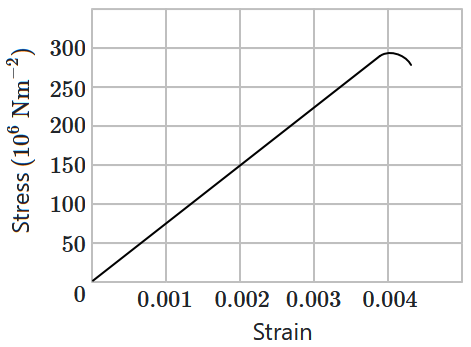The stress-strain curves are drawn for two different materials \(X\) and \(Y.\) It is observed that the ultimate strength point and the fracture point are close to each other for material \(X\) but are far apart for material \(Y.\) We can say that the materials \(X\) and \(Y\) are likely to be (respectively):
| 1. | ductile and brittle |
| 2. | brittle and ductile |
| 3. | brittle and plastic |
| 4. | plastic and ductile |
Subtopic: Stress - Strain Curve |
83%
From NCERT
NEET - 2019
To view explanation, please take trial in the course.
NEET 2026 - Target Batch - Vital
Hints
Links
To view explanation, please take trial in the course.
NEET 2026 - Target Batch - Vital
The figure shows the strain-stress curve for a given material. What is Young’s modulus for this material?

1. \(7.5\times10^{11}~\text{Nm}^{-2}\)
2. \(7.5\times10^{10}~\text{Nm}^{-2}\)
3. \(7.5\times10^{9}~\text{Nm}^{-2}\)
4. \(7.5\times10^{-10}~\text{Nm}^{-2}\)
Subtopic: Stress - Strain Curve |
79%
From NCERT
To view explanation, please take trial in the course.
NEET 2026 - Target Batch - Vital
Hints
To view explanation, please take trial in the course.
NEET 2026 - Target Batch - Vital
The stress-strain graphs for materials \(A\) and \(B\) are shown in the figure. The strength of the material \(A\) is:
(The graphs are drawn to the same scale)

| 1. | greater than material \(B\) |
| 2. | equal to material \(B\) |
| 3. | less than material \(B\) |
| 4. | insufficient data |
Subtopic: Stress - Strain Curve |
74%
From NCERT
To view explanation, please take trial in the course.
NEET 2026 - Target Batch - Vital
Hints
Links
To view explanation, please take trial in the course.
NEET 2026 - Target Batch - Vital
A large cylindrical piece of a dense solid elastic metal stands on its end as shown in the figure. The metal is uniform and isotropic. The stress in the material as a function of height is shown correctly by:


| 1. |  |
2. |  |
| 3. |  |
4. |  |
Subtopic: Stress - Strain Curve |
From NCERT
To view explanation, please take trial in the course.
NEET 2026 - Target Batch - Vital
Hints
To view explanation, please take trial in the course.
NEET 2026 - Target Batch - Vital


